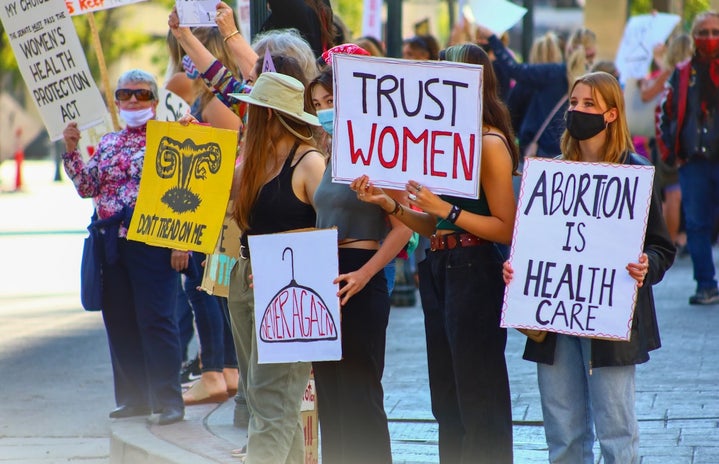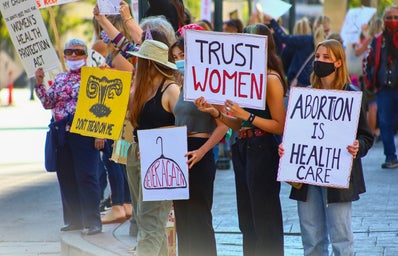The streets are filled with signs painted with ovaries and clothes hangers. Holding them are women, some alive long enough to remember the reproductive rights protests of the 1960s and 70s, others who were born into the results of them.
“My peer group had fought for abortion rights. [Younger generations] couldn’t believe that [Roe v. Wade] had been taken from them,” said Boston Globe columnist Ellen Goodman as she documented her experience at a protest right before the Dobbs v. Jackson Women’s Health Organization decision that overturned Roe. Goodman previously covered Roe in the 60s and 70s.
In 1973, after decades of struggle by American activists, the Supreme Court established national protections for abortion in the landmark Roe decision. Almost 50 years later, this decision was reversed in the landmark Dobbs decision. However, since 1973, public support for abortion has remained steady, according to PBS, Mass Live and the Pew Research Center. The media, as a powerful force on public opinion, likely played a role in this support.
What makes the media’s role in the national fight for reproductive rights an important issue to explore is the context in which the coverage was occurring. Post World War II, the government, media and business enterprises were used to advocate for a return to traditional gender roles after the increased autonomy that women had during the war. By the 70s, the conservative norm still dominated conversations about women in spaces of power—spaces that were occupied by men even more so than they are now. This norm advocated against reproductive freedom.
“Women are not truly free unless they control their reproductive systems,” said gender and race researcher and professor Patricia Davis.
Often, these discourses dominated public discussion and terminology in news stories around morality, religious ideas, and non-normative sexual behavior while ignoring intersectional issues.
With this background, it is especially surprising that the media was able to cover the abortion news story the way it did at the time and that public opinion grew to support abortion access. News writers approached the story of Roe as a story about the condition of abortion rights in each state. As Roe progressed from Texas to the national level, journalists explored the medical, legal, religious, political, and women’s rights implications of the court case. The breadth of coverage pushed the story into a variety of aspects of life. This coverage created an image of increased importance with every area it touched and managed to bring in nuance and intersectionality that likely had an impact on both the strength of public opinion and the perceived urgency of mobilization. This, in turn, had the power to impact both the decision and public reaction.
Furthermore, Davis argues that it was the media that made the connection between the women’s rights movement and the medical issue underlying the abortion debate. It did this by publishing scores of stories of women undergoing illegal, dangerous, and life-ending abortions such as Ms. Magazine’s “Never Again” issue. The issue featured police photos of a woman whose life was ended by an illegal abortion. However, out of the thousands of abortions in the 60s and 70s, there were less than 50 yearly deaths from induced or illegal abortions, according to the Pew Research Center. While these journalists maintained objectivity, a pillar of journalism ethics, the decision of what to print was less than objective.
However, to the detriment of news coverage, media companies encouraged reporters to cover both advocates and dissenters. Depending on what is being covered, this often creates false equivalencies, meaning that the media inadvertently gives voice, and consequently credibility, to reactionary movements. To cover both sides of the medical story associated with abortion, journalists included Mildred Jefferson in their stories, a Black female doctor and pro-life activist. At best, this gave an impression of medical disagreement. At worst, it undermined all medical information provided to the public about abortion and gave more weight to other angles of the argument such as the morality angle over the medical one.
The media has changed significantly since then. The rise of social media has created new ways to consume news. Traditional news sites have become increasingly institutionalized and much less powerful as a systemic watchdog; meanwhile, social media moves to take up the space and power of traditional news.
“Reporters and commentators are very influenced by being attacked by social media,” Goodman said.
While there was extensive coverage when the Dobbs decision came out, the media fell strangely silent about abortion leading up to the 2022 midterm elections. What little coverage there was focused on how it was not the main issue on voters’ minds. However, where abortion was decided by direct participation, voters decided to keep abortion access every time. This held true even in overwhelmingly red states like Kansas. According to Davis, more women registered to vote in the midterms. According to AP News, the New York Times, Fox News and the Texas Tribune after the election, many voters listed abortion as their key issue in the polls which is contrary to the original coverage. Democrats did not suffer the predicted and historical midterm losses that are typically suffered by the dominant party in power during a given cycle. The public mobilized in the ways they could despite the media’s failings, indicating a decrease in its influence on the public consciousness.
It is important to note that today the media has a broader understanding of intersectionality; it is better equipped to write about the ways in which marginalized communities are disproportionately impacted by a lack of abortion access. Similarly, the media is moving towards covering the post-Roe implications of the Dobbs case. This includes the increased importance of the availability of abortion pills and birth control and the attacks on both of those. Still, the mainstream media isn’t covering all of the issues related to abortion access. Ms. Magazine, a feminist magazine that has been hailed by the Washington Post as especially impactful to the reproductive rights movement, goes beyond national interest to cover the parental approval laws that restricted abortions for minors before Roe was overturned as well as local court cases that have infringed on abortion rights. These are not covered at all or not covered in the same detail in the mainstream media, according to Kathy Spillar, executive editor of Ms. Magazine and co-founder and executive director of the Feminist Majority Foundation, the organization that owns Ms. Magazine.
Nevertheless, the media continues to showcase the morality debate within their coverage. Although the leftist media has decreased its coverage of “both sides” of the abortion debate, they are still choosing to cover only stories of “moral agents.” According to Davis, moral agents are people who adhere to heteronormative ideals of sexuality and who despite this, need an abortion. For example, the Texas Tribune ran a story in September 2022 about a Texas woman who had to travel to Washington, D.C. to obtain an abortion because of a lethal fetal anomaly. The mainstream media purposefully leaves out women who don’t adhere to these norms, inadvertently crediting the moral argument of the anti-abortion movement.
Finally, as Goodman noticed during the protest she attended, there were two different perspectives within the groups of protestors. The women of her generation had lost something that they had worked for. The women of new generations had lost something that was their birthright.
“The perspective of having won something was quite different than the perspective of having something taken away,” Goodman said.


